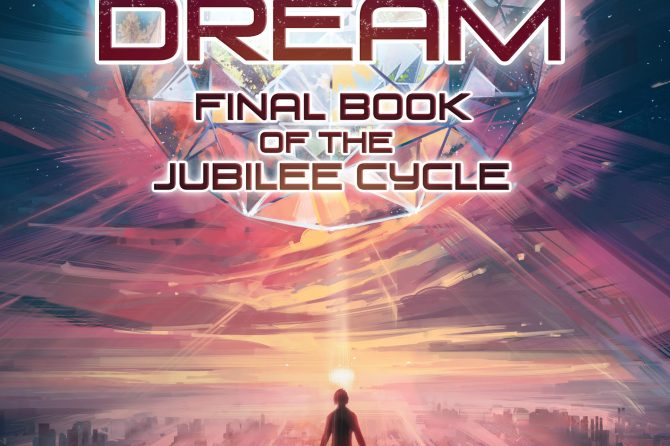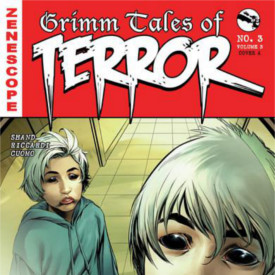I had initially thought I could cover all of the cover artists for the Ace Doubles who only did a half-dozen or so in one column; then I realized I hadn’t even finished with the main artists in the previous entry! Not to mention that not all of the cover artists are discoverable; because I only have a week to research, scan, and correct covers, I necessarily have to leave some out. And I can include only so many illustrations here, as well, so covering a 30-year span means I have to be choosy. There are a number of cover artists who only did one cover who I won’t even get to. So forgive me, dear reader, if the cover artists I speak about are the ones I feel deserve a mention.

When I linked to Dr. Smith’s web page last week, I forgot to mention one salient fact: that students or lovers of SF art—not just Ace Double art, though this is specific to it—might really enjoy his links to some scans of cover “roughs” by a number of artists. If you’re curious about how a piece comes to be a cover, these will give you some idea of how it worked in the past (I’m not sure how it has changed in the digital age). My information comes from talking to artists like Kelly Freas, Alex Schomburg, and George Barr, so it might be out of date.
Very basically, the Art Director (AD) will assign a cover to an artist, who then produces several preliminary sketches, or roughs, and the AD will select one, which the artist then turns into a finished cover. (Does the artist read the book before doing the cover? Usually, when they’re allowed to. I’ve been told that some artists are only given a précis of the book.) Sometimes the cover will need revision after it’s finished, but not too often—that’s why the roughs are made. On the D-series page, there are both pencil sketches and color roughs by Emsh (Ed Emshwiller) for various books, as well as scans of actual cover art; other original art and roughs are on other series pages (see Figure 1). A boon to the lover of SF art and the academic/student!
Getting back to the artists, I ran out of time and space (no jokes, please) last week and didn’t get in one of the more prolific cover artists, Grey Morrow. Morrow was primarily a comic book/strip/graphic novel-type artist. As such, his figures were often not as well-drawn (in my opinion) as some of the other artists’ were—anatomically, they weren’t always correct, and sometimes the poses were very awkward; one example (not shown here) was 51375, the Tarzan-like figure for Philip José Farmer’s Lord of the Trees (either an homage to Tarzan, or a parody of the same). Because Farmer did the same thing with Doc Savage (a book about “Doc Caliban,”), I think Morrow felt comfortable doing it with his cover; shown in Figure 2 right is Morrow’s “homage” to the Doc Savage covers by James Bama on Bantam Books’ paperbacks. Figure 2 left shows that Morrow could, and did, do competent SFnal covers; this one is vague enough, however, to work for any number of books. In short, Morrow did 15 covers over a three- or four-year stint (1966 or 1967 through Sept. 1970).

Another artist who did seven covers was Jerome Podwil. Podwil, unlike so many of the artists who did Doubles covers, is still alive, though according to what I could find out, he’s not doing paperback covers right now. I consider his Ace Double covers to be uninspired, although competent commercial art. So I’m not going to show you one; you can go to Dr. Smith’s page for a look at a couple of thumbnails. (If that sounds mean of me, consider that every cover picture I publish has about an hour’s cleanup work at best. The worst you don’t even want to hear about; I nearly have to repaint it myself!) Podwil did covers for the G, H and M series (around 1965-1966). And now we come to many people’s favourite Ace Doubles cover artist: Jeffrey Jones! Born Jeffrey Durwood Jones in 1944, Jones graduated from a Georgia university and began painting paperback covers in the mid-1960s; although he only did 6 Ace Doubles covers, the number of other covers painted for paperbacks was somewhere around 150, plus tons of black and whites, comics, etc. Jones painted in a classic style, and became renowned for fantasy work; examples of both the fantasy and the SFnal styles are in Figure 3 below. Tragically, although she was able to transition from male to female—becoming Jeffrey Catherine Jones in the process—her personal life brought her no peace, and she died of heart failure complicated by lung problems a few years ago. She was perhaps the most classically “painterly” of all the Ace Doubles cover artists. It’s reported (Wikipedia) that Frank Frazetta called her the “greatest living painter.”

Another artist who’s a favourite of mine, Josh Kirby, also did six Ace Doubles covers. (I had not known until recently that his real name was Ronald William Kirby and, according to Wikipedia, he acquired the nickname “Josh” at Liverpool School of Art from having his work compared to the great Joshua Reynolds’ work.) Although most people now would probably remember his work from the Terry Pratchett Discworld series of paperbacks—at least the British ones—he painted, besides his six Ace Doubles covers, around 200 other paperback covers for various publishers. An example of his Ace Doubles work is shown in Figure 4.

Another artist whose work was competent as far as commercial art but, to me, entirely uninspiring and forgettable was Harry Bergman, who did four Ace Doubles covers. I’ve been unable to find any information on Bergman or his art, except for some images on Google. For those who wish to pursue it further, they should look for the Philip K. Dick Ace Double (15697), comprising Dr. Futurity and The Unteleported Man, for example. The next most prolific, with four covers, is Michael Whelan. Whelan did a number of “two books in a single volume,” as in Marion Zimmer Bradley’s The Planet Savers and The Sword of Aldones, but because these books were not published in the familiar tête-bêche format, I don’t consider them Ace Doubles. Dean Ellis, another very popular “space” artist, did only three Ace Doubles, although he did covers for other books and many magazines. In my opinion, he—along with Valigursky (see last week)—was one of the few people who did space art reminiscent of the great SF films, including 2001. Figure 5 shows the kind of art Ellis was famous for (another familiar artist, who as far as I know never did an Ace double, was Vincent di Fate; his art is very reminiscent of Dean Ellis’s).

Finally, we come to those people who, for some reason or another, did only one or two covers. I don’t know who—whether it was Donald Wollheim or his Art Director(s)—selected who should do cover art, or how many covers each was allotted; the story behind that would be interesting, to say the least! Two artists who only did two covers each—one I’m showing, one I’m not—were Gerald McConnell and Peter Michael. Michael’s art (see G-606, Lin Carter’s Man Without a Planet) was commercial art by someone who knew nothing about SF and cared less, in my opinion. G-606 shows a man with some kind of glass dome—like a ‘50s space helmet from a cheap SF movie—over his head; the other one (G-632 Mack Reynolds’s The Rival Rigelians) shows three nearly formless people in what one assumes are space suits looking down at the viewer with arms raised in alarm; behind is a red moon and a yellow sun. Neither picture is particularly well painted, which is why I’m not showing either one here. The covers by Gerald McConnell are puzzling, to say the least (see Figure 6). The right-hand cover, for John W. Campbell’s The Ultimate Weapon, is a fairly standard, but well-executed SFnal cover; not exciting, but at least well done. The other, for Ursula LeGuin’s Rocannon’s World, is so badly executed that it appears the Art Director—or whomever—just took the cover rough and used it instead of allowing the artist to finish the piece. Could it have been a deadline issue? I guess we’ll never know.

And the last three artists I’d like to mention are George Barr—who is no longer doing cover art, enjoying a well-earned retirement, one assumes—Vaughn Bodé, and, finally, Alex Schomburg. I won’t publish the Barr cover here (71082, E.C. Tubb’s Lallia), because the actual art was reduced to the size of a postage stamp and placed in the middle of a black background covering the rest of the book save for the Ace logo, a blurb informing the reader it’s a “Dumarest” book, the author’s name and the book title. It’s embarrassing; and until I had to research this piece, I didn’t know that was a George Barr, who has a reputation for well-done fantasy and science fiction art. (He’s a devotée of ‘40s and ‘50s art, one can tell from his other SF work, but this cover doesn’t show it, and almost doesn’t show. Barr also did the frontispiece in his signature careful black-and-white style; Smith’s website erroneously credits the cover and frontispiece to artist Ken Barr, although the book itself does credit George properly.

Vaughn Bodé was well known for his Cheech Wizard comics, published in National Lampoon, and his style of cartooning is very obvious from Figure 7, for R.A. Lafferty’s Space Chantey (H-12). Bodé was enormously popular from both Lampoon and underground “comix”; it’s quite probable that he was also a significant influence on Ralph Bakshi’s film Wizards—although I don’t know whether Bakshi’s ever admitted it. It may be that it was too “cartoony” for Ace; whatever the reason, the Lafferty book is the only Ace Double Bodé ever did the cover for. And finally, we come to one of my favourite SF artists of all time: Alex Schomburg.

Alex Schomburg worked, as he told me, for Hugo Gernsback back in the Radio Craft days, then began illustrating interiors for Thrilling Wonder Stories, and then became a cover artist with Startling Stories in 1939. He became a significant comic book artist during the 1940s, doing many hundreds of covers for Human Torch, Captain America and other Marvel staples, although then it was Timely publications, not Marvel. In the 1950s, he went back to magazine illustration, doing dozens of covers in his signature smooth airbrush style. He also did the end papers—illustrating science fiction itself!—for the John C. Winston hardcover series of juvenile SF novels, as well as many of the covers for the same; the only Ace Double he illustrated—although he did at least one Ace single—was Emil Petaja’s Caves of Mars. I used to own the original cover rough for this book, which was—except for size—almost identical to the cover; I had to sell it some years ago when I underwent a period of financial hardship. But I had the pleasure of viewing it for some years, as well as the extreme pleasure of Alex’s friendship for many years. I will be telling the story of the Winston juveniles in a future Amazing Stories column.
My thanks go to Dr. Michael S. Smith at the University of North Carolina, Wilmington for his web page listing all the Ace Doubles he has information on; also to Steve Forty for some of the scans of books I don’t have. My collection is inadequate, and Steve had some I needed and volunteered to scan others. If you feel the desire to comment on this week’s entry, please register here, if you haven’t already—it’s free, and only takes a moment—or comment on my Facebook page or in the several groups where I publish a link. All your comments—good or bad—are welcome! Until next week, then!











Thanks for a nice conclusion to an interesting article, Steve.
Thanks, Gene! Keep watching the… blogs. I intend to review a lot of what impressed me years ago. (And I hope I don’t bore people while I do so!)